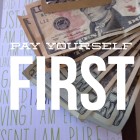This is the blog I almost didn’t write. Though the idea came to me the moment I posted my Radical Self Care New Year’s Wish, I dismissed it as too obvious and not worth writing. Everybody knows this, I thought. I told that to a friend who responded, “Write It. We don’t know. If we knew we’d be doing it.”
The “It” is simple…. Pay Yourself First.
It should have been obvious to me that this is a post that needs to be written, perhaps not for you, but for that one person who needs to know it, because it’s been my experience with clients that this is not common knowledge.
Many of my clients make more money than I do. Some make A LOT more. But even some clients who make millions have complained about money fears and stress. It used to surprise me. It no longer does. Clients with nice homes, new cars, great vacations, and beautiful wardrobes looked as if all was well. Upon further investigation, I discovered that these money-anxious clients had little to no savings, credit card debt, and were at times behind in their taxes. The patterns were the same whether their income was $50,000 or over $500,000 a year. No wonder they were stressed.
How does this happen?
These people aren’t dumb. They’re smart and creative and often doing great things in the world. It’s just that nobody taught them good habits with money.
So here’s one of the things I teach clients about money. Pay Yourself First. Decide on a percentage of your income and put it aside to invest BEFORE you do anything else. When clients say they can’t I recommend a minimum of 10%. It’s a nice easy number to remember and it won’t make a big dent in your lifestyle.
With some of my clients there is much grumbling, followed by explanations that it will be too hard, or that small a percentage won’t be enough to make a difference. But those who do it, and commit to it, turn their financial situation around in lightening speed. It continues to amaze me how fast it changes things. I believe the primary reasons this is so effective are:
- You bring consciousness to habits that were previously unconscious.
- You give yourself a message with every cheque you receive that you value yourself enough to invest in yourself.
- Priorities change once there is self-worth and consciousness brought to your relationship with money, and that has a systemic impact on spending, saving, and investing.
It’s important to know that this 10% is for investment only ~ something that will give you a return on your money. It’s about having your money work for you. That’s a critical part of this. An investment is not a $400 pair of Manolo Blahnik slippers or a week at a spa, no matter how much you think those will improve your life. If it’s not giving you a financial return, it’s not an investment.
You may think you don’t earn enough to pay yourself first, but if you don’t change your habits now, you’re going to keep spending and living in such a way that you won’t be able to afford it later. I was teaching these same principles to my retail staff in the 90’s who were earning between $7.00 and $12.00 an hour. If they can do it you can do it.
If you want to be smart with large sums of money, start being smart with small sums.
Another great excuse is that you’re an entrepreneur and don’t have a regular income. Spending lots of money when big checks come in and feeling broke when they don’t is like being caught in a dieting spiral of binging and starving and binging again. Neither are loving ways to treat yourself. Setting aside 10% of all your income creates a habit that grows over time, and creates a foundation that will give you peace of mind.
You may think you’ve got too many other things to worry about. You can’t focus on this now. Well, I learned this principle from my mom, along with “never spend more on your credit card than you can pay off completely when the bill comes”, and “have a year of expenses in savings for emergencies”.
You see when my mom was 33 years old my dad left her will all his debts and two kids. She could have crumbled under the pressure. Instead, she got a second, third, and fourth job, then used the extra money to pay off his debts and make investments. She bought her first house when she was 35 years old, and went on to build a real estate portfolio that enabled her to retire at 54 years old. She’s got a great attitude and super-human energy, but it shows you what is possible even in dire situations.
I’ve never been a financial wizard, and I don’t have to be. I make money decisions based on what feels good in my body. I don’t have a big house, expensive clothes, or a fat portfolio. But I do have peace. And a life I cherish ~ living by the beach, walking in the sunshine, spending time doing things I love with people I adore. I don’t work very much, and when I do it is profoundly fulfilling.
At 37 years old I was very sick and was told that I might never work again. I was shocked and scared. I had never expected to quit working so young. I was so very grateful that I had some investments to live on, even if I wasn’t ready to start living on them. I thought I’d have many more years to contribute to them, but you never know what life is going to bring your way. I’m healthy enough to be working again and you bet I’m paying myself first.
